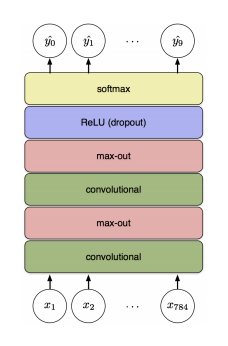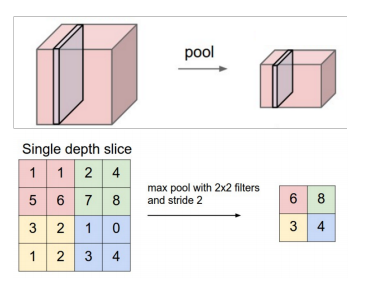上一个阶段构造的简单模型训练后,只有91%正确率。本文章讲解如何用一个稍微复杂的模型:卷积神经网络来提升效果。
下面是效果图:

具体的步骤为:
首先完成准备工作:
import input_data
import tensorflow as tf
#导入数据
mnist = input_data.read_data_sets('MNIST_data', one_hot = True)
#设置占位符和输入数据的格式
x = tf.placeholder("float", shape = [None, 784])
y = tf.placeholder("float' shape = [None, 10])
#784=>>28*28, 最后一维代表图片的颜色通道数,这里是灰度图为1,如果是rgb彩色图,则为3.
x_image = tf.reshape(x, [-1,28,28,1]) #定义权重初始化函数
在初始化W和b时应该加入少量的噪声来打破对称性以及避免0梯度。为了不在建立模型的时候反复做初始化操作,定义两个函数用于初始化:
#其实现在的W就是卷积核(filters),是不断学习的参数
def weight_variable(shape):
initial = tf.truncated_normal(shape, stddev = 0.1) # 从正态分布中取样,stddev表示标准差
return tf.Variable(initial)
def bias_variable(shaple):
initial = tf.constant(0.1, shape = shape)
return tf.Variable(initial)定义卷积和池化函数
def conv2d(x, W):
#x是输入,W是卷积核filter,[1,1,1,1]分别对应着输入数据的4个维度[batch, height, width, channels],在这里使用1步长(stride size),‘SAME’代表0边距(padding size)卷积过程超出图片的范围,用0代替。保证卷积后map大小和输入一样。
return tf.nn.conv2d(x, W, strides=[1,1,1,1], padding = 'SAME')
def max_pool_2x2(x):
#x是输入;ksize[1,2,2,1]对应着输入数据的4个维度,长度>=4;strides对应输入数据4个维度,长度>=4;‘SAME’代表0边距(padding size)
return tf.nn.max_pool(x, ksize = [1,2,2,1], strides = [1,2,2,1], padding = 'SAME')其中max pooling操作图为:

实现第一层卷积
如图1所示,由一个卷积接一个max pooling完成。
#卷积的权重张量形状是[5, 5, 1, 32],前两维度代表patch的大小为5*5,接着是输入的通道数目,最后是输出的通道数目。便于理解:输入的通道数相当于上一层的map数,输出的通道数目就是卷积核的个数,也就是下一层的map数。
W_conv1 = weight_variable([5,5,1,32])
#每一个输出通道都有一个对应的偏置量
b_conv1 = bias_variable([32])
#把x_image和权值向量进行卷积,加上偏置项,然后应用ReLU激活函数,
h_conv1 = tf.nn.relu(conv2d(x_image,W_conv1) + b_conv1) #1*28*28 ==> 28*28*32
#进行max pooling
h_pool1 = max_pool_2x2(h_conv1) # 32*24*24 ==> 14*14*32实现第二层卷积
W_conv2 = weight_variable([5,5,32,64])
b_conv2 = bias_variable([64])
h_conv2 = tf.nn.relu(conv2d(h_pool1, W_conv2) + b_conv2) #32*14*14 ⇒ 14*14*64
h_pool2 = max_pool_2x2(h_conv2) #64*14*14 ==> 7*7*64密集连接层
图片尺寸减小到7x7后,加入一个有1024个神经元的全连接层,用于处理整个图片。
W_fc1 = weight_variable([7*7*64, 1024]) #转换成flat vector
b_fc1 = bias_variable([1024])
h_pool2_flat = tf.reshape(h_pool2, [-1, 7*7*64]) #将上一层的输出也转换成flat vector
h_fc1 = tf.nn.relu(tf.matmul(h_pool2_flat, W_fc1) + b_fc1) #relu(W*x+b)的形式加入dropout,防止过拟合
keep_prob = tf.placeholder("float") #用一个placeholder来代表一个神经元的输出在dropout中保持不变的概率.在训练过程中启用dropout,在测试过程中关闭dropout
h_fc1_drop = tf.nn.dropout(h_fc1, keep_prob)输出层
W_fc2 = weight_variable([1024, 10])
b_fc2 = bias_variable([10])
#添加一个softmax层
y_conv = tf.nn.softmax(tf.matmul(h_fc1_drop, W_fc2) + b_fc2)训练和评估模型
cross_entropy = -tf.reduce_sum(y_*tf.log(y_conv)) #定义loss函数
train_step = tf.train.AdamOptimizer(le-4).minimize(cross_entropy) #定义训练算法,这里使用更加复杂的ADAM优化器
sess = tf.InteractiveSession() #开始一个会话
sess.run(tf.initialize_all_variables()) # 初始化变量
#在训练之前定义准确预测操作
correct_prediction = tf.equal(tf.argmax(y_conv1, 1), tf.argmax(y_, 1))
accuracy = tf.reduce_mean(tf.cast(correct_prediction, "float"))
#训练模型
for n in range(20000):
batch = mnist.train.next_batch(50)
if n%100 == 0:
train_accuracy = accuracy.eval(feed_dict = {x:batch[0],y:batch[1],keep_prob: 1.0})
print "step %d, training accuracy %g" %(n, train_accuracy)
sess.run(train_step, feed_dict = {x:batch[0], y:batch[1], keep_prob: 0.5})
#评估准确率
print "test accuracy %g" %accuracy.eval(feed_dict = {x:mnist.test.image, y:mnist.test.labels, keep_prob: 1.0})以上代码,在最终测试集上的准确率大概是99.2%。






















 475
475

 被折叠的 条评论
为什么被折叠?
被折叠的 条评论
为什么被折叠?








